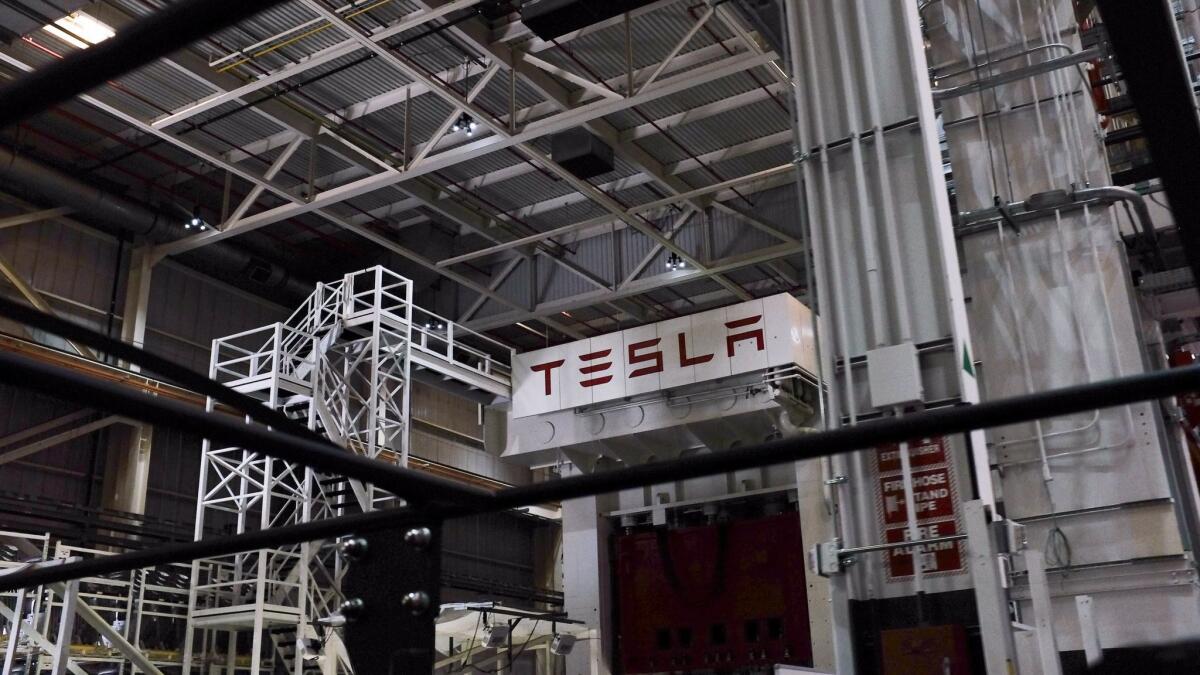Why you’re being left in the dark about coronavirus hot spots in your area

According to Tesla, more than 10,000 people work at its electric-car assembly plant in Fremont, Calif. How many have been infected with COVID-19?
Tesla won’t say. Neither will the Alameda County Public Health Department. The county, which includes the cities of Fremont and Oakland, cites federal health privacy law to explain the silence.
But experts say the law in question is not so clear cut. And elected officials and worker advocates are beginning to speak out, not only about Tesla but also about the tight hold public health agencies are keeping on information that could better inform the public on matters of life and death.
Some go so far as to say the agencies, by withholding detailed information about where COVID-19 is clustering, risk losing the support of the people they are trying to protect.
“When you’re not giving people that kind of information, people get justifiably cynical,” said Santa Clara County Supervisor Dave Cortese, who has grappled with his own public health department over data transparency.
“My constituents start to wonder, how serious is this really?” he said. “On the one hand, they’re told it’s important to wear masks, that businesses need to shut down. On the other hand, they won’t tell me where the clusters [of cases] are. This isn’t about transparency for the sake of transparency. It’s about whether my neighbor should head to the convenience store because there’ve been 14 infections there.”
The issue is especially charged in Alameda County, where Tesla defied public health orders and reopened the factory a week earlier than the date the county had given.
Chief Executive Elon Musk invited officials to arrest him. The county caved, the plant reopened, and thousands were back at work on the assembly line.
In a recent internal email sent to workers by Tesla safety head Laurie Shelby, the company acknowledged workers have been infected but didn’t say how many. The email also claimed that all infections occurred outside the factory, with “zero Covid-19 workplace transmissions.” The email offered no details on how it could have reached that conclusion. The Washington Post reported the existence of cases at Tesla on Tuesday.
Alameda County has the highest number of COVID-19 cases in Northern California; since Musk defied the county order May 11, cumulative cases have more than doubled, up 104% from 2,064 to 4,207 by Sunday.
Across Alameda’s eastern border in San Joaquin County, where housing is relatively affordable to factory workers, cases are up 149% since May 11, to 1,550. Santa Clara County — the heart of Silicon Valley, with housing prices among the highest in the nation and filled with software specialists who can work from home — had more cases than Alameda on May 11 but now has 983 fewer. Its case count since May 11 is up only 27%.
The public doesn’t know whether Tesla contributed to Alameda’s mushrooming caseload, and if so, by how much. The Alameda County Public Health Department has the numbers but is keeping them confidential.
An Alameda County spokeswoman said federal health privacy law prevents disclosure of the Tesla data. Asked to specify exactly which parts of the law prohibit dissemination of aggregated data, the spokeswoman sent a link to the language of the law — the Health Insurance Portability and Accountability Act — and offered no further comment.
Alameda County Administrator Susan Muranishi declined a request for comment. Alameda’s top health officer, Dr. Erica Pan, also declined. Four of the five elected Alameda County supervisors did not return phone calls or emails from The Times. A representative for Supervisor Scott Haggerty said, “Maybe next week.” Tesla did not respond to a request for comment.
All workers deserve to know whether their business place is a coronavirus hot spot, said Mara Ortenburger, communications and research head at Worksafe, a workers rights group. “They deserve to know so they can take steps to support themselves and their family” by deciding whether to go to work or not, she said. “It’s especially crucial if they have elder or immunocompromised family at home.”
Sallie Milam, deputy director of the Network for Public Health Law, said employer data “also might provide management incentive to comply with public health orders and provide measures to protect their workforce.”
Tesla workers have complained about receiving only scant information about coronavirus infections at the Fremont plant, the San Francisco Chronicle reported. “They said you don’t need to know unless you’re on the trace end of it,” a worker told the Chronicle, referring to efforts to trace infected workers’ contacts.
Data transparency has become a hot topic among county health officials across the country, said Lori Freeman, CEO of the National Assn. of County and City Health Officials. “There’s been a lot of pressure on health departments to release information,” she said. “They started out being very conservative, but the pressure has mounted over time” — pressure, she said, mainly from elected officials.
Many health officials echo Alameda County’s contention that HIPAA, on the books since 1996, prevents any disclosure of public health information that could identify an individual.
But the law is complicated. “It’s a labyrinth of regulations,” Milam said. Many health agencies are taking too strict an interpretation of the law, said Al-Amyn Sumar, an attorney at the Ballard Spahr law firm in Washington. HIPAA gives some leeway to public health agencies, especially if there are state laws that supersede HIPAA.
“There would be minimal privacy interest” in more site-specific location information but “a significant public interest in knowing where the outbreaks are happening and what the public health response is to that,” he said. It’s unclear how California law fits into his analysis, he said.
In Iowa last month, the Black Hawk County Health Department, under pressure from the public and the news media, announced that 1,031 workers had been infected at a Tyson Foods meatpacking plant there.
Public health agencies generally are unaccustomed to public controversies over data release and tend to be conservative, Milam said. Provisions in HIPAA could be interpreted as barring identification of an employer, she said. But there’s a way for public health agencies to free themselves from the HIPAA yoke. It involves an organizational structure change into a “hybrid entity.”
The concept is simple: Public health agencies are subject to HIPAA when they provide any health services directly to patients. That makes the agency “covered” by HIPAA. Even one practicing physician on staff makes the entire health agency a covered entity. If the health agency doesn’t provide health services, it doesn’t come under HIPAA. Large counties throughout the U.S. typically provide health services.
Any covered agency can convert itself into a hybrid agency, however, by creating an information wall between the health providers and the rest of the public health department, Milam said. The California Department of Public Health, for example, is a hybrid entity.
Pre-pandemic, public health agencies in general were under no pressure to make the conversion, and many may not even know the option exists.
Freeman, of the county and city health association, said she’s intrigued. “The pandemic is going to change a lot of things,” she said. “It’ll cause us to pause and determine whether what we have in place fits our needs and perhaps readdress” some policies.
The Times emailed the Alameda County spokeswoman Friday morning and asked whether the health department had ever considered becoming a hybrid entity or might consider it in the future. Thus far, there’s been no response.







